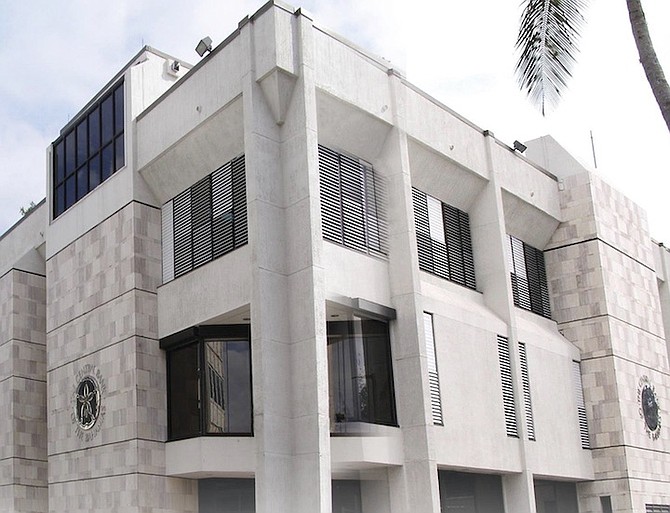By NEIL HARTNELL
Tribune Business Editor
nhartnell@tribunemedia.net
The Central Bank is “holding off” in determining whether COVID-related loan delinquencies have peaked despite a $22.4m reduction in non-performing credit during the 2022 first quarter, its governor revealed yesterday.
John Rolle, in written replies to Tribune Business questions, said that while too early to determine if the three months to end-March represent “an entrenched trend of reduction” it did signal that the worst of the pandemic’s fall-out for the banking sector and its borrowers may have passed although non-performing loans still total over half-a-billion dollars.
“As the system moved through the first quarter, there was a $22m reduction in non-performing loans,” the governor told this newspaper. “Although it is too soon to conclude that this is an entrenched trend of reduction, it does underscore important moderation and stabilisation in the environment since the height of the pandemic.
“We are holding-off on concluding whether there has been a peak until after the summer months. As it now stands, the non-performing loan rate was 9.3 percent in March 2022 compared to 9.6 percent at the end of 2021, but it is still higher than in March 2021 when the rate was 8.7 percent.”
Meanwhile, although The Bahamas’ first-ever credit bureau is now operational, Mr Rolle said its reports on existing and potential borrowers - and their creditworthiness - will not be complete until the process of acquiring data from sectors such as the credit unions and public utilities is complete. No timeline for this was provided, with one of the Central Bank’s commercial bank licensees also yet to start supplying customers’ data to the credit bureau.
“The credit bureau is now in operation. All but one of the commercial banks have started submitting data. The last bank will begin to transmit information this month. This submission is expected to match the same historical back series length as was submitted by the other institutions,” the Central Bank governor affirmed.
“Some banks have also began to query the bureau for reports, which they are using to supplement their internal information systems. However, the completeness of the credit reports is not assured until all of the important providers are on board, including credit unions and public utilities. That process is ongoing.”
The credit bureau’s creation is designed to provide banks and other formal lenders with a more complete and accurate history of a borrower’s credit history - whether they are current with their loan obligations; if they are meeting them in full and on time; and how much debt they are currently carrying as well as their ability to service existing and future borrowings.
The centralised database provided by the bureau will mean that Bahamians will no longer be able to bounce from one lending institution to another, obtaining credit at each. The improve information should also help lenders better assess and price borrower risk, so that those with good credit histories end up with lower interest (debt servicing) costs. The Bahamian lending market, in theory, should become more transparent and efficient with improved access for good borrowers.
Meanwhile, Central Bank data showed that total private sector arrears - loans that are between 30-90 days past due, as well as those past 90 days and non-performing - declined by $38.9m or 5 percent during the 2022 first quarter. Non-performing loans, which accounted for the bulk of the reduction, fell by 4.3 percent during the first three months of 2022.
“Disaggregated by loan category, consumer arrears reduced by $27m (10 percent) corresponding with a fall-off in both long and short-term delinquencies by $17.9m (8.9 percent) and by $9.1m (13.3 percent) respectively,” the Central Bank said.
“Similarly, residential mortgage arrears decreased by $17.1m (3.9 percent) as the short-term segment declined by $14.1m (8.8 percent) and the non-performing balance by $3.1m (1.1 percent). Conversely, commercial arrears grew by $5.2m (7.3 percent) as the short-term component rose by $6.7m (28.2 percent), overshadowing the $1.5m (3.1 percent) reduction in non-accrual loans.
“Over the three-month period, commercial banks’ total provisions for loan losses contracted by $17.7m (3.5 percent). However, the ratio of total provisions to arrears rose by 1.1 percentage points, and the ratio of total provisions to non-performing loans by 0.8 percentage points. For the review quarter, banks wrote-off approximately $21.5m in overdue loans and recovered an estimated $12.8m.”
Non-performing loans totalled $505.5m at end-March 2022, having declined by $29m that month - a development which more than offset the $7m rise during the year’s first two months. “Concentrated on shorter-term delinquencies, banks’ credit quality indicators softened during March as total private sector arrears rose by $15.6m (2.1 percent) to $740.9m, with the accompanying ratio higher by 34 basis points at 13.6 percent,” the Central Bank said.
“By age, short-term arrears (31-90 days) grew by $44.5m (23.3 percent) to $235.3m with the associated ratio increasing by 83 basis points to 4.3 percent. In contrast, non-performing loans reduced by $29m (5.4 percent) to $505.5m, resulting in the attendant ratio narrowing by 50 basis points to 9.3 percent - with decreases in non-performing loan rates for consumer loans by 95 basis points to 9.1 percent; mortgages by 21 basis points to 10.9 percent; and commercial loans by 30 basis points to 5.2 percent.”






Comments
Use the comment form below to begin a discussion about this content.
Sign in to comment
Or login with:
OpenID